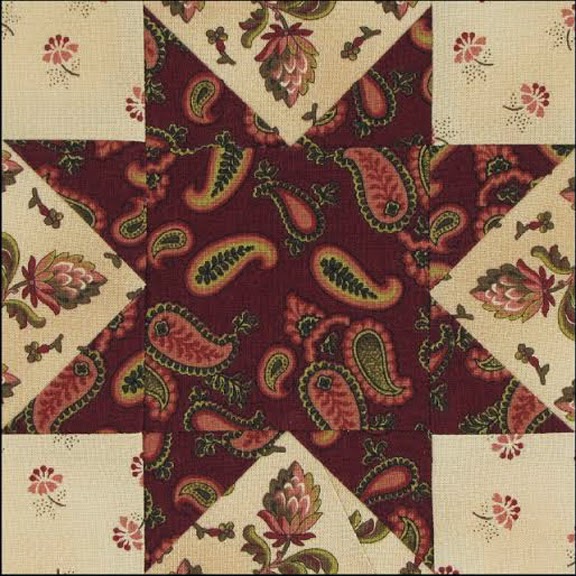Reproduction block with a paisley star by Becky Brown
Tintype of a woman in a cashmere shawl, about 1860
What we call paisleys derive from woven cashmere shawls, which originated in India’s Kashmir region, home to soft wools and deft weavers.
Vintage British quilt about 1820-1840
Traditional patterns included stylized botanicals focusing on a cone or seedpod shape, seen in the lilac border on the right. This oval with a curled tail was known as the botha or boteh (from the Hindi buta for flower).
Textile manual in German from the
New York Public Library
The botanical source for the boteh design is in some dispute. Some textile historians see it as a pinecone, others as a gourd or the shoot of a date palm, possibly associated with fertility.
Portait of a woman by William Powell Frith.
Is she wearing an expensive Kashmir shawl or
a European knock-off?
The fashion for wool shawls also inspired imitation cotton prints, first known as shawl prints.
Mid-19th-century quilters developed a passion for cotton prints that imitated the colors as well as the designs of the shawls.
Mid-19th-century quilters developed a passion for cotton prints that imitated the colors as well as the designs of the shawls.
Reproduction with the document swatch from my
Civil War Homefront collection.
Madder dyes used in wool shawls also worked well with cotton printing processes.
The prints were popular for dressing gowns (wrappers) and furnishings for the boudoir so there were many sewing scraps, but the style was so important for quilts that much yardage must have been sold just for patchwork.
Vintage block about 1870-1890
One sees these madder-style paisleys in quilts from the 1860s into the 1890s. The high point of the style seems to be the 1870s and ‘80s.
Vintage print from the last half of the 19th century
Paisley figures were often set in striped sets, which quilters
liked for borders and strips
and everything else....
Block dated 1875
Vintage print from the 20th century
Cone shapes were also set in what textile designers
call a tossed set.
Paisley dresses from 1968
A serious paisley revival took place in the 1960s; the cones here
in a tossed set.
Vintage quilt about 1870-1900
Sashing strips include a tossed paisley on the sides
and a stripe paisley on the bottom.
Paisley from the early 19th century
set foulard style, or in a staggered half-drop repeat.
Reproductions
Shawn used a paisley center as a contrast to a lighter foulard background.
Terrific reproduction of mid-century madder style taste.
Flying Geese from Nancy's Quilts webpage, 1998.
You need tossed sets, stripe sets and foulard sets
in your paisley collection
Detail of a paisley reproduction by Roseanne Smith
Rue Indienne by French General for Moda
Three of mine: Striped set, tossed set and grid set
Another of my repros in a stripe set.
Reproduction star by Becky Brown
The dark paisley foulard in the background is from
Alice's Scrapbag, my fall Moda collection.
The repro is the redder print in the corner. The other is the original.
Sales reps are showing this collection to shop owners right now.
It's both a paisley and a foulard. And a madder-style print too.
Two of Nancy Gere's many paisley repros.
Paula Barnes does
border stripes and neat stripes.
Pam Weeks
Moda Collections for a Cause: Charity
Jo Morton's Caswell County:
Foulards and Paisleys
Voila by Jo Morton
Border is the Leesburg indienne print below
in a different colorway
Jo Morton Leesburg
Atelier by 3 Sisters
A tossed set in colors popular in the 1880s and '90s,
a different brown with more green in it than red.
More on bronze colors later.
Paisleys Gone Wild by Becky Brown
What to Do with Your Stack of Stars?
Alternate with a Nine Patch.
The star is based on a Nine Patch with a proportion of 1:2:1 so a block based on the same geometry goes well.
My sewing group alternated stars and nine-patches
in our Summer Birthdays William Morris quilt.
Summer Birthdays by the Sew Whatevers
I found the same idea in Quilts by Katlin,
A few years ago Moda's Three Sisters did a Hollywood and Vines quilt
alternating the star with a four patch in the middle of the nine patch
One More Thing About Paisley Prints
Sandra Dallas’s 1995 novel about a quilting club in Kansas during the Great Depression established the name Persian Pickle for the boteh design. I could find no 19th-century references to “Persian Pickle” or anything that didn’t have to do with Dallas’s book. That’s the thing about good fiction—it can make you believe it’s all very real.
See a discussion of that name in my post and in the comments. In Russian they called the boteh a Gherkin.














VKBRQU0bWSQ!~~60_57.jpg)





































